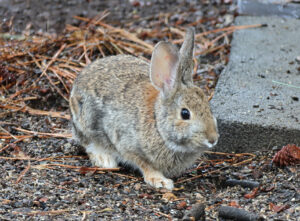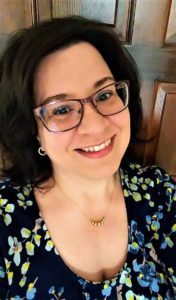I wake and pad out to my makeshift garden. I had cleared a small area in the yard to grow three lettuces, two cucumbers and five tomato plants. You might call me a COVID cliché with my gluten-free sourdough starter and a half-assed victory garden. But there is no sense of victory as I notice another leaf gone from the small bunch of romaine that had seemed healthy a few days ago. Something was working its way inward. After pushing the leaves back and watching small gnats disperse into the cool morning air, I can only think of the rabbit in our yard. He and I have had our indoor/outdoor staring contests over the months, each of us curious about who was on the other side of the glass. Depending on his pose, he is sweet and charming, or he is a grumpy old man, back leg askance as he wiggles his nose at me.
I have in mind to rake the garden dirt near the lettuces, but next to my bucket of trowels and hand rakes there is a dead something that stops me short. A knot of pink, yarn-like intestines gleams—a relatively fresh kill. The rabbit? Too small. Perhaps a mouse killed by the neighborhood cat that uses our yard as a thoroughfare. My husband, Marc, takes a closer look and determines it is what’s left of the torso of a crow. After walking around the yard for a few minutes, he finds the site of the massacre—a few still-shining black wing feathers and what appears to be part of a shoulder. That and the intestines are all that is left. There is a lone crow up in the pine tree where yesterday there were two; it looks down at me, perhaps considering the remains of its friend or partner, and caws loudly. I’m sorry, I tell the crow, and I cry.
These are my first tears in months, the ones I have been waiting for. The ones I expected when my friend was hospitalized. The ones I expected when I lost my job. The ones I expected when I watched the video of George Floyd gasping for air.
We move about our days separately, Marc on a myriad of conference calls and me training for a new job and trying to write. We’ve both been saddened by the remains of the crow and are unsure what to do. We settle on leaving it as food for another animal. Later, I walk the yard to the site of other bird deaths: the back corner where the house finch was killed by a hawk, the pine tree where I placed a junco after it hit a window and broke its neck. Marc comments on the cruelty of nature, but this is not exactly what I’m thinking. There is a kind of queasiness in both my gut and my brain that comes from recalling Henry David Thoreau’s phrase of “living lives of quiet desperation.”
My tears came from the amalgamation of all the pressures of daily life these past months, compounded by violence that can only be caused by hatred. The feeling of desperation comes from a desire to return to some kind of normalcy. The queasiness, however, comes from wondering if life was truly normal before COVID. Re-reading Walden reminds me that Thoreau’s actual definition of desperation is performing a life based on the status-quo because people believe there are no other choices available. In other words, normal is defined by those around us unless we choose to see some other potential for ourselves. My normal a few months ago was a vocation that gave me a “life-title” (teacher) while running myself into the ground giving away as much of myself to other people as possible while trying to manage some shred of equanimity about the world’s affairs. After all, that’s what everyone else was doing, right?
This new iteration of normal is something else—of learning skills as potential avenues for a new-to-me life. When I laugh about my bread-making, it is because public opinion has changed to make fun of those who are trying to bake without store-bought yeast. Few people want to acknowledge the comfort provided by an intellectual and physical activity which also provides nourishment. To call attention to this need for comfort is to acknowledge what others see as a personal weakness or flaw (hence, Tamagotchi metaphors) rather than confronting our true fear—that life will most likely never return to our previously-defined normal.
The author and artist Austin Kleon questioned our collective queasiness over our disrupted normal routines by asking why we’ve “rushed to fill the void with livestreams and podcasts and Zoom calls…” Left to our own devices, we may not want to imagine any new lives for ourselves. The old ways were predictable, comfortable. Now we have a choice to make. Do we take these ongoing isolation moments as a time to change the way we think and act, or do we fill our lives with busy-ness so we don’t have to spend time alone with our own selves? To observe the world around us now and to reflect on what we will no longer tolerate is to understand that we cannot go back to a time before.
The remaining crow feathers blow around in the dirt, returning slowly to the earth. Some have been carried away by the wind. I continue to water the lettuce for the rabbit’s benefit. I decide that I will not be the kind of human who will fight with, or against, nature. I don’t know much more than this right now. Sometimes, there are moments when I lose my breath wondering how to craft a new life without a template. The desperation I feel happens only when I think about the amount of time I believe I have left.


